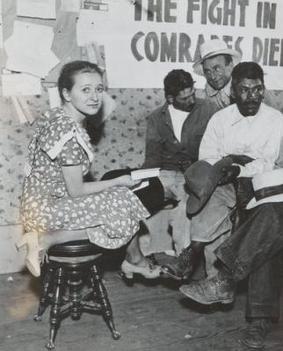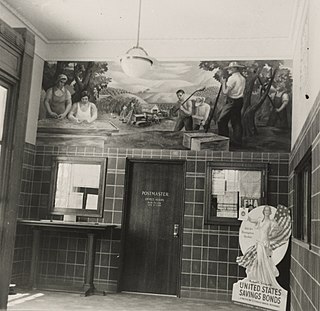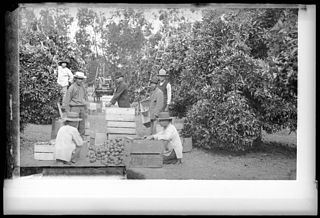
In Dubious Battle is a novel by John Steinbeck, written in 1936. The central figure of the story is an activist attempting to organize abused laborers in order to gain fair wages and working conditions.

The Delano grape strike was a labor strike organized by the Agricultural Workers Organizing Committee (AWOC), a predominantly Filipino and AFL-CIO-sponsored labor organization, against table grape growers in Delano, California to fight against the exploitation of farm workers. The strike began on September 8, 1965, and one week later, the predominantly Mexican National Farmworkers Association (NFWA) joined the cause. In August 1966, the AWOC and the NFWA merged to create the United Farm Workers (UFW) Organizing Committee.
The Colonia is a neighborhood located in the central portion of the city of Oxnard, California, USA. The neighborhood was laid out by the Colonia Land Improvement Company in close proximity of the sugar factory and beet fields to house workers just east of the city's downtown business district. Long a Latino barrio, it is home to lower-income families, former resident César Chávez once lived there, also known worldwide as Boxnard because of La Colonia Youth Boxing Club, which has produced notable fighters such as Fernando Vargas, Robert Garcia, Miguel Angel Garcia, Victor Ortíz, Brandon Rios and Mia St. John.
The Hardin County onion pickers strike was a strike by agricultural workers in Hardin County, Ohio, in 1934. Led by the Agricultural Workers Union, Local 19724, the strike began on June 20, two days after the trade union formed. After the kidnapping and beating of the union's leader and the intervention of the Ohio National Guard on behalf of the growers, the strike ended in October with a partial victory for the union. Some growers met the union's demand for a 35-cents-an-hour minimum wage, but the majority did not.

The Salad Bowl strike was a series of strikes, mass pickets, boycotts and secondary boycotts that began on August 23, 1970 and led to the largest farm worker strike in U.S. history. The strike was led by the United Farm Workers against the International Brotherhood of Teamsters. The Salad Bowl strike was only in part a jurisdictional strike, for many of the actions taken during the event were not strikes. The strike led directly to the passage of the California Agricultural Labor Relations Act in 1975.

Caroline Decker Gladstein was a labor activist in the 1930s in California. A member of the Communist Party, as many activists were, she was an organizer for the Cannery and Agricultural Workers’ International Union (CAWIU). Decker helped organize the massive California agricultural strikes of 1933 during the Great Depression.

The California agricultural strikes of 1933 were a series of strikes by mostly Mexican and Filipino agricultural workers throughout the San Joaquin Valley. More than 47,500 workers were involved in the wave of approximately 30 strikes from 1931 to 1941. Twenty-four of the strikes, involving 37,500 union members, were led by the Cannery and Agricultural Workers' Industrial Union (CAWIU). The strikes are grouped together because most of them were organized by the CAWIU. Strike actions began in August among cherry, grape, peach, pear, sugar beet, and tomato workers, and culminated in a number of strikes against cotton growers in the San Joaquin Valley in October. The cotton strikes involved the largest number of workers. Sources vary as to numbers involved in the cotton strikes, with some sources claiming 18,000 workers and others just 12,000 workers, 80% of whom were Mexican.
The Cannery and Agricultural Workers Industrial Union (CAWIU) was a Communist-aligned union active in California in the early 1930s. Organizers provided support to workers in California's fields and canning industry. The Cannery and Agricultural Workers Industrial Union (CAWIU) dated back to 1929 with the formation of the Trade Union Unity League (TUUL). With industrialization and the advent of the factories, labor started migrating into the urban space. An influx of immigrant workers contributed to the environment favorable to big business by increasing the supply of unskilled labor lost to the urban factories. The demand for labor spurred the growers to look to seasonal migrant workers as a viable labor source. Corporations began to look at profits and started to marginalize its workers by providing sub-par wages and working conditions to their seasonal workers. The formation of the Cannery and Agricultural Workers Industrial Union addressed and represented the civil rights of the migrant workers. Ultimately the CAWIU lost the battle, overwhelmed by the combined alliance of growers and the Mexican and state governments. The eventual abandonment of the Trade Union Unity League led to the dissolution of the CAWIU, which later emerged as the United Cannery, Agricultural, Packing, and Allied Workers of America (UCAPAWA).

The Vacaville tree pruners' strike of 1932 was a two-month strike beginning on November 14 by the CAWIU in Vacaville, California, United States. The strikers were protesting a cut in tree pruning wages from $1.40 for an eight-hour workday to $1.25 for a nine-hour workday. The strike was characterized by multiple violent incidents including a break-in at the Vacaville jail that resulted in the kidnapping and abuse of six arrested strike leaders. The strikers were ultimately unsuccessful in demanding higher wages and fewer hours and the CAWIU voted to end the strike on January 20, 1933.
The Cantaloupe strike of 1928 was labor movement of cantaloupe pickers in Imperial Valley, California. On May 7, 1928 cantaloupe pickers walked off of the job and the strike lasted to May 10 of the same year. The strikers had hardly any outside support and many were effectively imprisoned by local police for gathering together in any public space during the strike. The strikers were mostly Mexican immigrants or of Mexican descent because they comprised the vast majority of produce laborers in California, about 3,500 to 4,000 Mexicans worked as cantaloupe pickers. While the strike was short-lived and seemingly unorganized, it stands as a victory for the workers.
The Imperial Valley lettuce strike of 1930 was a strike of workers against lettuce growers of California's Imperial Valley
The Santa Clara cannery strike occurred during the summer of 1931. Workers spontaneously walked out of canneries in order to protest a 20% cut in wages. These workers were met with violence from local authorities, and strikebreakers were brought in to replace the workers. While this strike was unsuccessful, it marked the beginning of organizing cannery workers.
The El Monte berry strike began on June 1, 1933, in El Monte, California. It was part of the largest California agricultural strike of 1933, organized by the Cannery and Agricultural Workers’ International Union (CAWIU). The berry strike affected local Japanese farm owners and growers.
The Pacific Electric Railway strike of 1903 was an industrial dispute between Mexican tracklayers and their employers on the construction of the Main Street streetcar line in Los Angeles. The dispute began on April 24 when the workers, known as the "Traqueros", demanded higher wages to match those of the European immigrants working on the same project, and stopped work. It ended on April 29 when the union organising the strike failed to persuade workers on rest of the streetcar system to join the strike, and the labourers returned to work.
The Salinas California lettuce strike of 1934 ran from August 27 to September 24, 1934, in the Salinas Valley of California. This strike of lettuce cutters and shed workers was begun and largely maintained by the recently formed Filipino Labor Union and came to highlight ethnic discrimination and union repression. Acts of violence from both frustrated workers and vigilante bands threatened the strike's integrity.
The 1933 Yakima Valley strike took place on 24 August 1933 in the Yakima Valley, Washington, United States. It is notable as the most serious and highly publicized agricultural labor disturbance in Washington history and as a brief revitalization of the Industrial Workers of the World in the region.
Pat Chambers was an influential labor organizer and Communist Party member in the 1930s in California. He was a key figure in some of the largest California agricultural strikes of 1933. Chambers was the inspiration for the character "Mac" in John Steinbeck's 1936 novel, In Dubious Battle.
The Associated Farmers of California was an influential anti-labor organization in California between 1934 and 1939. Agricultural and business leaders formed the organization to counter growing labor activism in California. The AF was responsible for substantial violence in reaction to agricultural strikes; the creation of anti-picketing ordinances; and spying on the activities of labor organizations. After a US Senate investigation into its actions and the advent of WW2, it lost influence and eventually disbanded. “The reign of the AF would only come to an end when the LaFollette Committee turned its scrutiny towards its activities in 1939 and 1940." The committee's attention short-circuited the AF's attempt to expand across the United States.”
Antonio Orendain was a Mexican immigrant to the United States where he worked as an agricultural worker and Union activist. He is known for his work as a part of the Community Service Organization (CSO) from 1953 to 1962, as well as his work alongside Cesar Chavez as a part of the National Farm Workers Association (NFWA). Orendain later went on to found the Texas Farm Workers Union (TFWU) to specifically organize agricultural workers in Texas.

The Citrus Strike of 1936 was a strike in southern California among citrus workers for better working conditions that took place within various cities within Orange County, such as Fullerton and Anaheim from June 10 to July 25. There were multiple factors that led the citrus workers to strike including their paid wages, working conditions, living conditions, and overall social dynamics. The strike itself was significant for ending the myth of "contented Mexican labor." It was one of the most violently suppressed strikes of the early 20th century in the United States. The sheriff who suppressed the largely Mexican 3,000 citrus pickers was himself a citrus rancher who issued a "shoot to kill" order on the strikers. The aftermath of the strike effort led to 400 citrus workers being arrested in total, while others were forced to either face jail time or possible deportation back to Mexico. It has also been referred to as the Citrus War and the Citrus Riots.







